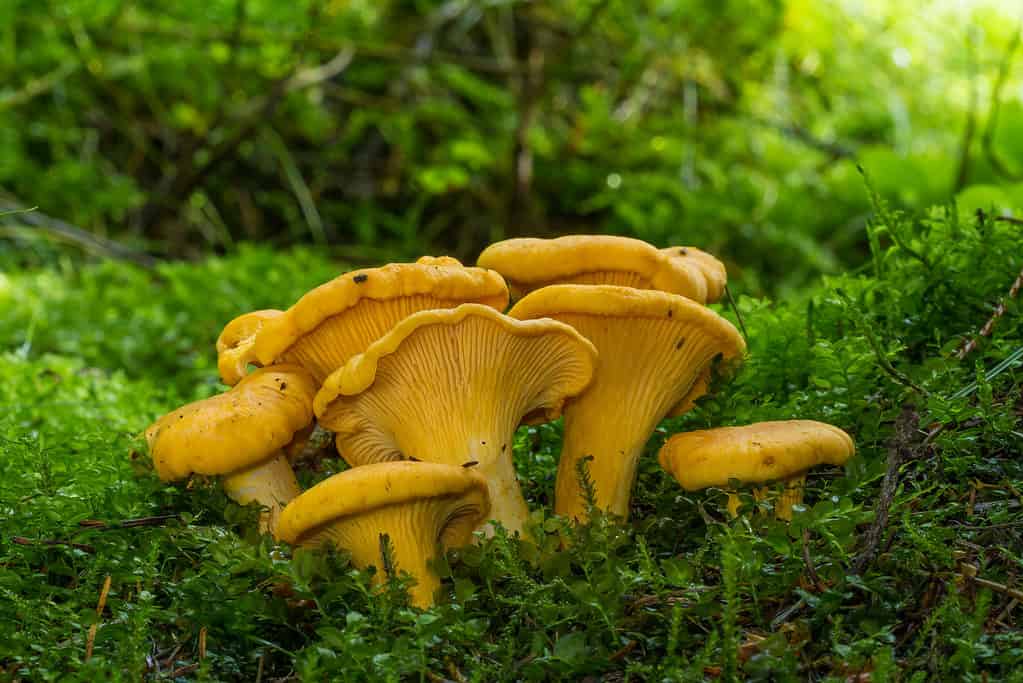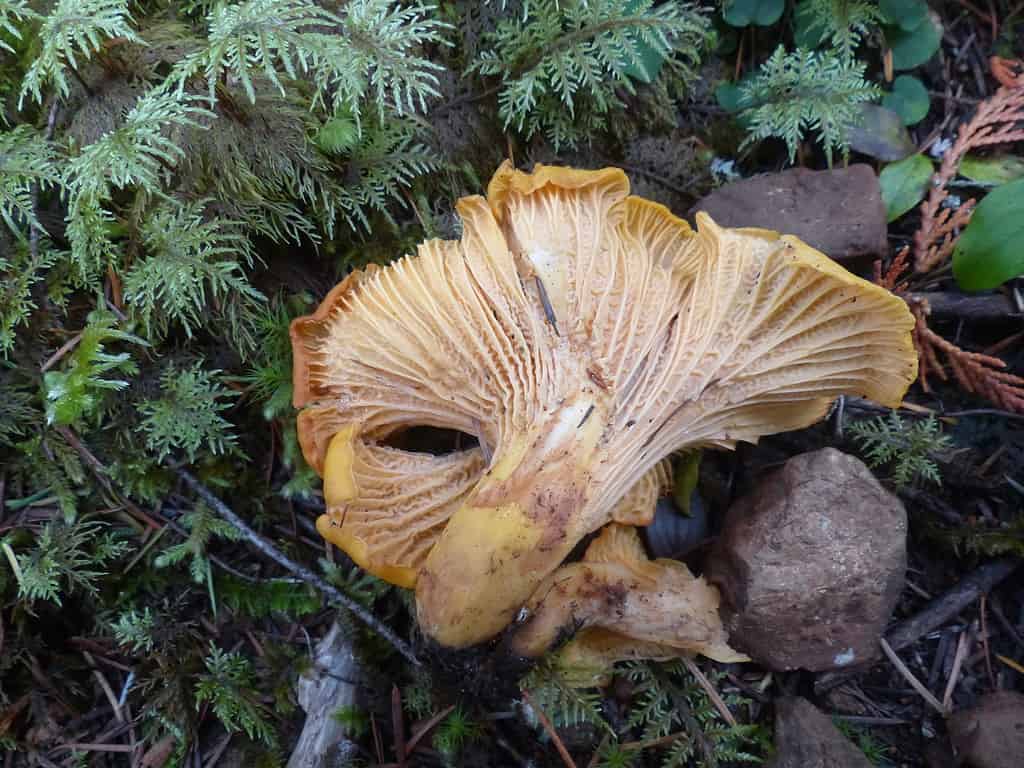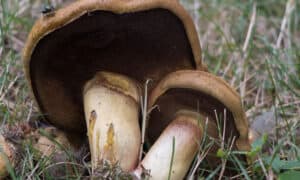If you’ve recently foraged or purchased a bounty of chanterelle mushrooms, you may be wondering about the best way to store them. Especially considering these are choice, delicious edible mushrooms, you’ll want to make sure you store them in a manner that extends their freshness, integrity, and taste.
In this guide, we’ll provide a brief overview of these delectable mushrooms, how to accurately ID them in the wild, and finally, we’ll cover how to store chanterelle mushrooms.
Read on to learn more.
Chanterelles: an Overview
Most chanterelles belong to the Cantharellus genus of mushrooms. These choice, edible, wild mushrooms occur throughout temperate, woodland areas of Africa, Europe, North America, South America, Asia, and Australia. Many species exist, including over a dozen in North America. More species are being discovered relatively often. They are well-regarded for their tender, meaty texture and complex, nutty, earthy, and slightly fruity taste. Plus, they can be found fruiting in large quantities!
All chanterelles form mycorrhizal associations with the roots of trees. The term mycorrhizal describes a symbiotic nutrient exchange between the underground, filamentous part of a fungus (mycelium) and the roots of a plant. The mycelium makes its way throughout the soil, acquiring water and nutrients, such as magnesium and phosphorus, to provide to the plant roots. In exchange, the plant provides carbon and essential sugars to the fungus. Mushrooms in the Cantharellus genus can form mycorrhizal associations with hardwood or conifer trees, depending on the species.

Cantharellus cibarius (commonly known as the chanterelle or golden chanterelle) grows in the forest.
©godi photo/Shutterstock.com
How to Identify Chanterelle Mushrooms
Before learning how to store chanterelle mushrooms, if you’re going to be foraging for them, it’s essential to know how to accurately I.D. them. You can find chanterelles in a range of colors, primarily golden-yellow, yellow-brown, pale-yellow, tan-white, and cinnamon-red. Some people even say there are blue chanterelles. The latter two colors only apply to a small handful of species. Note that jack-o-lantern mushrooms (various Omphalotus species) are toxic and can look similar to chanterelles. Check out our guide on them here.
Where and When They Grow
Since chanterelles are mycorrhizal, you aren’t likely to find them growing attached to deadwood, from manure, grass thatch, or on the trunks of living trees. Instead, the mycelium of chanterelles sends up their mushrooms directly from the soil, often close to the tree they have formed an association with.
Depending on the species, you can find them growing in conifer, hardwood, or mixed-wood forests. The Pacific golden chanterelle (Cantharellus formosus), for example, is mycorrhizal with conifer trees and commonly grows in lower-elevation, second-growth Douglas fir forests.
Depending on the region and species, chanterelles can fruit from late spring and mid-summer into early fall. Or even in some areas, they are found in the winter. You may find them growing alone, scattered, or densely across the forest floor.
Morphological Characteristics
You can identify chanterelles through several characteristics that often overlap across species. For example, when mature, most species feature a funnel-shaped fruiting body. They tend to smell fruity, specifically of apricots. The vast majority of species in Cantharellus are not hollow inside and can easily split in half down vertically. Some species of the genus Craterellus can be considered chanterelles too though, and those are normally hollow.
False Gills vs. True Gills
All species in the Cantharellus genus have false (or primitive) gills. You can distinguish false gills from true gills by examining the look and feel of the spore dispersal tissue. You can easily move true gills by brushing your thumb across them. They are fragile, often easily damaged, are easy to separate from the rest of the fruiting body, and are slit-like.
False gills, on the other hand, often present more like rubbery ridges underneath the cap. They don’t easily move, are less slit-like, and you can’t easily separate false gills from the rest of the fruiting body. They feel more like part of the mushroom than something that is attached to it. False gills on chanterelles are typically forked and will run partially down the length of the stem (aka the stipe).
There is variation among species in the appearance of the false gills. Some species of chanterelles, like the smooth chanterelle (Cantharellus lateritius), appear almost completely smooth under the cap. The Appalachian chanterelle (Cantharellus appalachiensis), on the other hand, has much more defined false gills that look closer to true gills.

An underside shot of the Pacific Golden Chanterelle aka Cantharellus formosus
©jstraka aka J Straka / https://creativecommons.org/licenses/by/4.0/ https://inaturalist.ca/photos/102002070 – License
How to Store Chanterelle Mushrooms
If you have brought home a bounty of foraged chanterelles or purchased them from a farmer’s market or grocery store, you’ll want to make sure to store them properly. Chanterelles can be quite expensive, so it’d be even more of a shame if these gourmet mushrooms ended up prematurely spoiling from improper storage.
A note on cleaning: if you have foraged your chanterelles, it’s a good idea to clean them up before storing them. However, it’s best not to wash these mushrooms under flowing water or through soaking. Instead, you can gently clean them with a dry toothbrush, paper towel, or a damp toothbrush.
How to Store Chanterelle Mushrooms: Refrigeration
If you want to know how to store chanterelle mushrooms in a manner that extends their longevity, texture, and taste, then keep them in the fridge. Specifically, you’ll want to store them in a paper bag. By doing so, you’ll reduce moisture accumulation and allow ventilation.
If you foraged your chanterelles, and they’re a bit moist, it’s best to pat them dry with a paper towel before refrigerating. You’ll also want to store them whole since slicing them quickens the spoilage timeline. Cutting the mushrooms allows for faster colonization of mold species and more oxidation damage. Fresh, unwashed chanterelles should last in the fridge for at least 5 days if not longer.
Pantry Storage
If you don’t have access to refrigeration, the next best way to store your fresh chanterelle mushrooms is in a pantry or similar setup. The goal is to find a dry, dark, cool, clean area to store them. Sunlight, heat, oxidation, moisture, and damage will also speed up the spoiling process. So you’ll want to store them in a manner that counteracts these factors. In a cool, dark, and dry storage environment, your chanterelles should last a few days.
How to Store Chanterelle Mushrooms: Duxelles
While some mushrooms, such as shiitakes, are excellent dried, chanterelles lose much of their amazing flavor when dehydrated. Even worse, when you reconstitute them the texture turns out leathery. If you find that you have an overabundance of fresh chanterelles, you can cook them into decadent mushroom duxelles. This French method of cold-storing mushrooms involves dicing and sauteing your chanterelles before freezing. This method of preservation retains the delicious flavor of the chanterelles. You can use the duxelles for future stuffing, sauces, and soups.
Let’s say you have 3 pounds of chanterelles that you’d like to preserve with this method. For this amount of mushrooms, the ingredients and measurements for a traditional duxelles would be as follows:
- 3 lbs. of fresh chanterelles
- 1.5 teaspoons of salt
- 1 teaspoon of fresh ground black pepper
- 4 tablespoons of butter (dairy or vegan) or vegetable oil.
- 3 tablespoons of shallots, diced to 1/4 inch
- 3/4 cup dry sherry or dry white wine
- 1.5 teaspoons of fresh chopped thyme
Cooking Instructions
1. You’ll want to finely chop the mushrooms by hand into a fine dice.
2. Over medium heat, add in the butter or veggie oil and cook the shallots until they are translucent. Then, add the chanterelles, salt, pepper, and fresh thyme. Stir every couple of minutes.
3. After about 3-5 minutes, you’ll notice that the chopped mushrooms have released their moisture content. Keep cooking for about 5 more minutes until the liquid evaporates.
4. Next, deglaze the pan with the dry sherry or white wine and cook for another roughly 5 minutes until all moisture has fully evaporated from the pan.
5. At this point, you can taste-check your duxelles and continue seasoning to your liking.
Once cool, your duxelles are ready to freeze. Some folks prefer to freeze them in ice cube trays, pop them out, and then store them in freezer bags for easy portions. With proper storage in the freezer, the chanterelles will retain a fresh, delicious taste for up to three months.

Duxelles can be made in different ways and can be added to all kinds of dishes. Use your imagination!
©alexmak7/Shutterstock.com
The photo featured at the top of this post is © muuraa/Shutterstock.com
The information presented on or through the Website is made available solely for general informational purposes. We do not warrant the accuracy, completeness, or usefulness of this information. Any reliance you place on such information is strictly at your own risk. We disclaim all liability and responsibility arising from any reliance placed on such materials by you or any other visitor to the Website, or by anyone who may be informed of any of its contents. None of the statements or claims on the Website should be taken as medical advice, health advice, or as confirmation that a plant, fungus, or other item is safe for consumption or will provide any health benefits. Anyone considering the health benefits of particular plant, fungus, or other item should first consult with a doctor or other medical professional. The statements made within this Website have not been evaluated by the Food and Drug Administration. These statements are not intended to diagnose, treat, cure or prevent any disease.
Thank you for reading! Have some feedback for us? Contact the AZ Animals editorial team.






